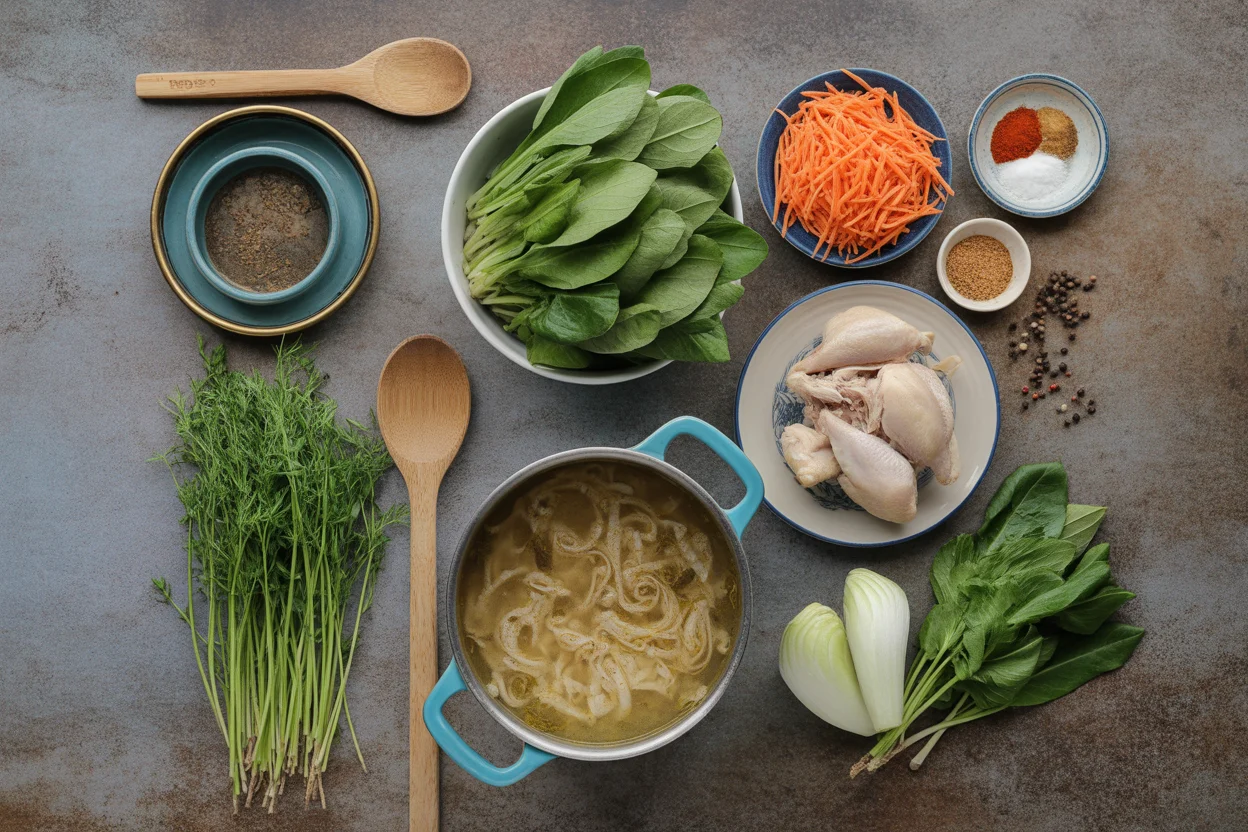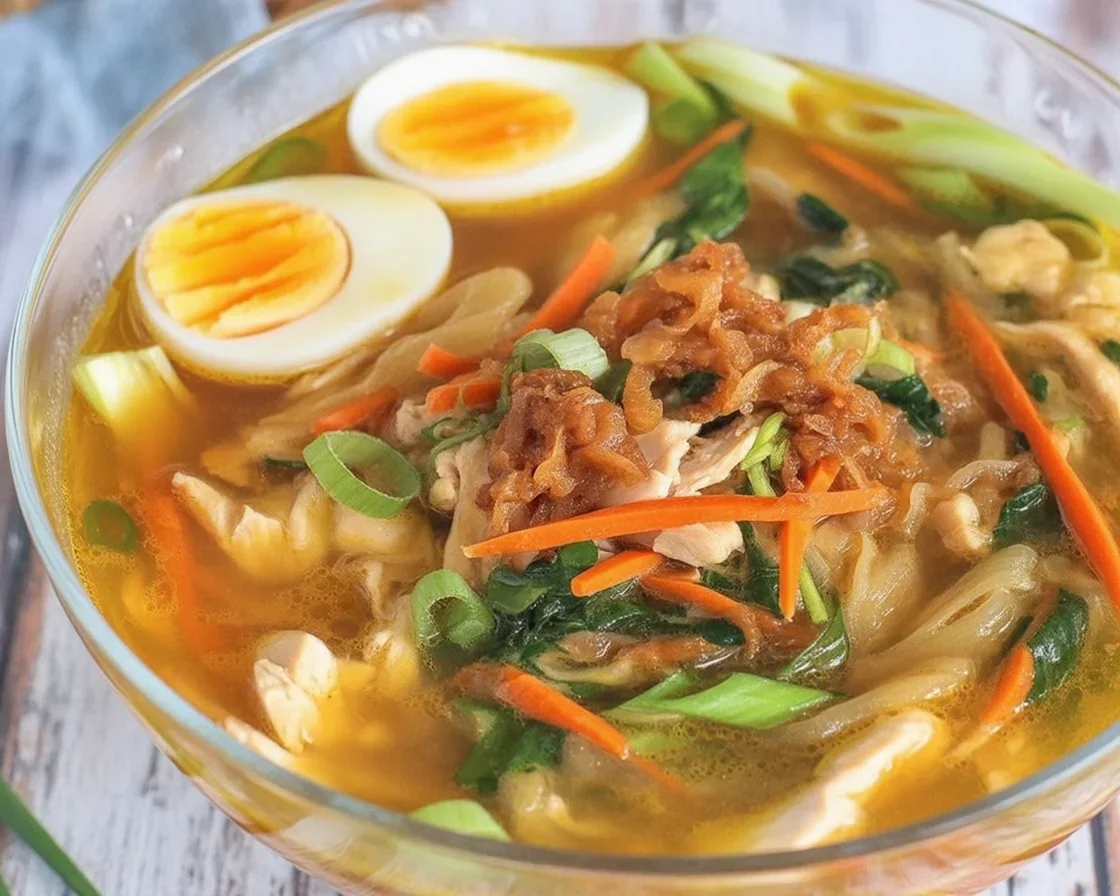- Overview of sotanghon soup
- Preparing chicken broth
- Cooking glass noodles
- Adding vegetables
- Seasoning
- Serving hot
- Comfort food tips
- Common Questions
- A Warm Bowl For Every Day
Filipino sotanghon soup is basically the superhero for anyone shivering on a rainy afternoon, stuck battling a cold, or just hit with those random hunger pangs at the weirdest times. Have you ever found yourself wanting a bowl of something hot, but not too heavy? This is it, seriously. There’s a special warmth packed in sotanghon soup with chicken that honestly, no store-bought stuff can beat. If you love noodly, slurp-able comfort (and who doesn’t?) this recipe is about to be your new favorite. You can always dive into other Filipino soups too, like this classic chicken sotanghon or even go bold with beef bone marrow soup. Anyway, let’s get you cozy and cooking.

Overview of sotanghon soup
Sotanghon soup isn’t just another noodle dish. It’s one big bowl of Filipino-style nostalgia. The magic’s in those glass noodles. They look kinda fancy but actually, they’re pretty forgiving for first-timers. Add some shredded chicken and you’ve got a soup that feels like someone tucking you in. In my family, when the rain starts thumping down and Netflix won’t stop glitching, this is what everyone asks for by name. I love how simple the ingredients are, but still—once you put them together, the result is pure five-star restaurant material (or at least, better than anything under a heat lamp).
There’s another reason this soup matters: it’s super flexible. No chicken? Use leftover turkey (I admit, I did one time and nobody even noticed). Noodles running low? Mix with regular vermicelli if you gotta. The best comfort food adapts to whatever’s rattling around in your pantry.
Here’s where it gets a little silly: sometimes you’ll see folks arguing at the market about the “right” sotanghon noodles to get. Ignore ’em—any decent glass noodle will do! Oh, and it reheats like a dream. So, don’t stress if you accidentally make a giant pot. Trust me, it always disappears.

Preparing chicken broth
Okay, real talk: if you want Filipino sotanghon soup that actually tastes like homemade goodness, you gotta start with a solid broth. This is basically the soul of your bowl! Don’t skip or rush it. I almost did once. Not worth it.
Take chicken legs or thigh pieces (bone-in will give you more flavor, but boneless is okay if that’s what you’ve stashed in the freezer). Plop ’em in a pot, add water, a bit of salt, onion, and maybe a smashed garlic clove. Let this simmer gently. Don’t let it roar like a volcano or you’ll end up boiling out all that flavor.
Here’s my granny-tip: skim off the bubbles for a clear broth. Simple, but it makes a difference! Let it go for around 30-40 minutes until the chicken is cooked through and your kitchen smells like you should be opening a soup café.
When it’s done, pull out the chicken, let it cool a smidge and shred it. Chuck the bones (or save them for dog snacks, if you do that. No judgment!). Keep the broth—this is about to be the cozy base for all the yum.

Cooking glass noodles
So, glass noodles—also called sotanghon—are those slippery, clear noodles you see floating beautifully in the bowl. Now, honestly, they can be a bit mischievous if you’ve never worked with them. But don’t sweat. Quick tip? Soak them in warm water until soft, maybe 10 minutes. Don’t just boil ’em direct or you risk gummy, tangled little disasters!
After soaking, drain ’em and set aside. When it’s time (right before serving, really), drop the noodles into your simmering broth and let them cook for just a few minutes. Watch them like a hawk—they go from perfect to overdone in a miracle minute.
A weird little secret: if you let them sit in the bowl with the hot broth, they’ll keep softening. So serve up quick, or you’ll end up with a bowl of mushy sadness instead of that beautiful, slippery texture.
Some folks like to snip their noodles shorter. I don’t, but if you’re feeding small kids, it does make the whole process a heck of a lot less messy.
“I followed this step-by-step and my sotanghon noodles were finally not a sticky mess! My kids actually asked for seconds.” – Cara, Houston, TX
Adding vegetables
Vegetables are where this soup really gets its little pops of color. I’m all for the classic carrots and cabbage combo. Thinly sliced carrot gives a tiny crunch and cabbage wilts perfectly into everything. Sometimes I’ll toss in a handful of green onions too—totally optional, but always welcome.
Just don’t add them all at the start! Wait until your broth is simmering, drop the carrots in first ’cause they’re tougher, then add the cabbage near the end so it doesn’t turn into sad mush. Veggies in this Filipino sotanghon soup should still have their personality. Honestly, I’m sneaky and add whatever’s lurking in my crisper—mushrooms, snap peas, even baby spinach, if that’s all I’ve got.
If you want even more healthy ideas for hearty soups, check out this lineup of soups and stews or see what’s cooking in the healthy Filipino recipes collection. Sometimes we all need inspiration, right?
Seasoning
Seasoning is like the sprinkle of magic dust that takes Filipino sotanghon soup from “meh” to “how is this so good?” For me, a good slosh of fish sauce pulls the flavors together. If you’re not into fish sauce, soy sauce works. Black pepper—lots—is a must for that warm finish.
Some people like a dash of calamansi juice or lemon for brightness. Up to you, but wow, it really perks everything up. I started adding it after my cousin insisted—it just stuck.
Salt should be added at the very end. Remember: fish sauce and soy sauce are salty, so taste as you go unless you want a salt bomb (and nobody wants that, trust me).
Like things spicy? Toss in some whole peppercorns, or float a hot chili on top. If you’re serving the family, maybe leave the chili on the side and let folks add their own.
Serving hot
Serving Filipino sotanghon soup is when everybody at the table starts hovering, bowls out, ready to pounce. Don’t be shy—heap it in! Top with more green onions or fried garlic bits if you wanna get fancy. Here are my favorite ways to serve it up:
- Ladle hot soup straight into deep bowls (the noodles get slippery, so use a big spoon!).
- Add a wedge of lemon or calamansi for an extra zing.
- Sprinkle crispy fried garlic or green onions on top. No shame in store-bought garlic bits.
- Pair with a mug of hot tea for pure rainy day bliss.
You can also make it the star of a family meal with a spread of classic Filipino favorites. If you want to go all out, try serving it alongside beef stews or check out these kid-friendly recipes for extra easy crowd-pleasers.
Comfort food tips
Honestly, Filipino sotanghon soup is all about making your life easier and warmer. My house rule: double the recipe, stash the rest in jars for surprise hunger attacks. It keeps well and honestly, it’s even tastier the next day.
Use what you’ve got. Don’t panic if you’re out of cabbage—baby bok choy works. Cheap rotisserie chicken in the fridge? Shred it up, tastes awesome. I’ve even swapped in bits of leftover pork adobo for something different. (Sure, not traditional. But doesn’t food taste best when it’s a little rebellious? I say yes.)
Let the soup cool a bit before storing so those noodles don’t melt into mush. And if you wanna get super extra, freeze just the broth and add noodles fresh each time for almost-instant comfort, no sadness guaranteed.
Meeting a picky eater challenge? Give them just noodles and chicken, veggies on the side. Boom! No whining, just happy slurping.
Common Questions
How do I stop my noodles from overcooking? Watch ‘em close! Add soaked glass noodles at the last minute and serve the soup quick. They’ll keep softening in the hot broth.
Can I use chicken breast? Of course, but chicken with bone has a deeper flavor. Breasts cook fast — don’t let them get too dry.
What other veggies can I use? Basically, anything! Bok choy, spinach, or even mushrooms all work. Use what’s available and don’t stress.
Is fish sauce a must? Not really, but it gives a classic Filipino flavor. Soy sauce works if that’s all you got.
Does this soup freeze well? The broth freezes perfectly. Just don’t freeze noodles — cook those fresh when you reheat the soup.
A Warm Bowl For Every Day
So there you have it — Filipino sotanghon soup with chicken, all ready to warm your soul. It’s humble, flexible, so easy you’ll never grab the instant stuff again. Go ahead, experiment a little! And when you’re ready to branch out, check inspiration like this Chicken Sotanghon Soup, variations from Foxy Folksy, or the step-by-step guide from Salu Salo. Time to pour yourself a steamy bowl, kick back, and let the comfort kick in.

Sotanghon Soup
Ingredients
For the Broth
- 4 pieces chicken legs or thighs Bone-in for more flavor, but boneless is okay.
- 8 cups water
- 1 teaspoon salt
- 1 medium onion, quartered
- 1 clove garlic, smashed Optional
For the Soup
- 200 grams sotanghon (glass noodles) Soak in warm water for 10 minutes before use.
- 1 medium carrot, thinly sliced Adds crunch.
- 2 cups cabbage, chopped Add towards the end of cooking.
- 1 bunch green onions, chopped For garnish.
- 2 tablespoons fish sauce Can substitute with soy sauce.
- 1 teaspoon black pepper To taste.
- 1 tablespoon calamansi juice or lemon juice Optional for brightness.
Instructions
Preparing the Broth
- In a pot, combine chicken legs or thighs, water, salt, onion, and garlic.
- Simmer gently for 30-40 minutes until chicken is cooked through.
- Skim off any bubbles for a clear broth.
- Remove chicken, let cool slightly, then shred.
- Keep the broth for the soup base.
Cooking the Glass Noodles
- Soak sotanghon in warm water for about 10 minutes until soft, then drain.
- Right before serving, add noodles to simmering broth and cook for a few minutes.
- Serve immediately to prevent overcooking.
Adding Vegetables
- Add sliced carrots to the broth first, then add cabbage towards the end of cooking.
- Feel free to add other vegetables as desired.
Seasoning and Serving
- Season with fish sauce, black pepper, and calamansi or lemon juice.
- Ladle soup into bowls, top with green onions and serve hot.

